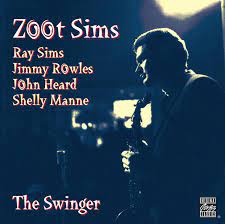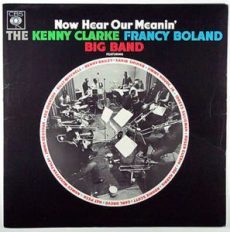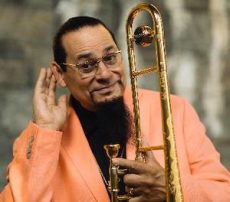
Daily Dose Of Jazz…
Ray C. Sims was born on January 18, 1921 in Wichita, Kansas. He played in territory bands during the early 1940s, then shortly after the end of World War II he recorded with Anita O’Day and Benny Goodman.
From 1947 to 1957 he worked with Les Brown and with Dave Pell from 1953-1957. Sims would go on to work with Harry James from the late Fifties to 1969, and also worked as a sideman with Charlie Barnet, Bill Holman, and Red Norvo.
The 1970s saw Ray playing with James again and with Corky Corcoran. Near the end of the decade he recorded with his younger brother Zoot. Trombonist Ray Sims transitioned on March 14, 2000.
More Posts: history,instrumental,jazz,music,trombone

Daily Dose Of Jazz…
Nathan Peck was born on January 13, 1925 in New York City and began playing the trombone as a teenager. After leaving high school he was drafted into the army and became part of Glenn Miller’s band. He remained with the band until after World War II ended.
He played with Don Redman in 1947 and studied classical music at the Paris Conservatory from 1949 to 1951, while playing and recording with leading jazz musicians such as Coleman Hawkins, James Moody, and Roy Eldridge. During the 1950s Peck played on television in New York, and in 1953 he recorded with Dizzy Gillespie. He shuttled between Paris and New York until 1957, when he married dancer Vera Tietz, then settled in France.
In France, he played with Michel Legrand, André Hodeir and Duke Ellington. Spending some time in England and Germany, Nathan worked as a staff musician at Sender Freies Berlin and played with Quincy Jones and the Clarke-Boland Big Band from 1963 to 1969. Relocating to London, England in 1965, he became active in the studios, film, and television. He played with Benny Goodman in the early Seventies and with Peter Herbolzheimer by the end of the decade.
Later he worked mainly as a contractor with his company, London Studio Orchestras. While this led to him ending his playing career, he shifted his talents to putting together the best blend of session musicians that he could find. ‘The Italian Job’, ‘Yentl’, ‘The 3 Muskateers’, and many more great films, especially with French composers Michel Legrand and Philippe Sarde.
Trombonist Nathan Peck transitioned on October 24, 2015.
More Posts: history,instrumental,jazz,music,trombone

STEVE TURRE
A colossal presence in the music, Steve Turre has garnered praise and amassed countless accolades from such respected outlets as DownBeat, JazzTimes, and JazzIz for his unique mastery of both trombone and seashells. The former Jazz Messenger has performed with innovative, genre-defining artists, including Ray Charles, Dizzy Gillespie, McCoy Tyner, Herbie Hancock, the recently departed Pharoah Sanders, and Rahsaan Roland Kirk, who would prompt Turre’s sonic exploration of shells. His Generations outfit champions bandstand mentorship, embracing the new era of creative artists: Wallace Roney, Jr., Emilio Modeste, Isaiah J. Thompson, and Orion Turre.
Showtimes ~ 7:30pm | 9:30pm
Lineup
Steve Turre, trombone, shells
Marquis Hill, trumpet
Ben Solomon, tenor and soprano saxophones
Davis Whitfield, piano
Corcoran Holt, bass
Orion Turre, drums
More Posts: adventure,album,club,festival,genius,jazz,museum,music,preserving,restaurant,shells,travel,trombone

CONRAD HERWIG & THE LATIN SIDE ALL~STARS
The Django is proud to welcome acclaimed trombonist Conrad Herwig and his Latin Side All-Stars to our stage for a weekly Tuesday residency. In this special engagement, He brings an ace septet to the Django stage, playing Latin versions of Miles, Mingus, Hancock, Coltrane and more!
Herwig has recorded 26 albums as a leader, receiving four GRAMMY®-nominations for his own projects. His latest CD release is The Latin Side of Mingus (Savant; 2022) . This is a follow-up project to The “Latin Side of …” tributes to Horace Silver (Savant; 2020), Joe Henderson (Half Note; 2014), Herbie Hancock (Half Note; 2010) Wayne Shorter (Half Note; 2008), Miles Davis (Half Note; 2004), and John Coltrane (Astor Place; 1996). These exciting and individualized projects feature an array of special guests including Randy Brecker, Ruben Blades, Michel Camilo, Joe Lovano, Eddie Palmieri, Paquito D’Rivera, Dave Valentin and many of the hottest players on the international scene.
Equally facile in a non-Latin arena, Conrad has been voted #1 Jazz Trombonist in DownBeat Magazine “Jazz Critic’s Poll” and nominated for “Trombonist of the Year” by the Jazz Journalists Association on numerous occasions. In constant demand as a sideman, heg has performed with Joe Henderson, Horace Silver, McCoy Tyner, and Joe Lovano (featured as a soloist on Lovano’s GRAMMY® Award winning 52nd St. Themes CD). In the Afro-Caribbean genre he has toured with legends such as Eddie Palmieri, Tito Puente, Paquito D’Rivera, and Michel Camilo. He is a longtime member of the the Mingus Big Band (where he has served as musical director and arranger including on the 2011 GRAMMY- winning “Live at the Jazz Standard”). In other big band settings Herwig has also performed and recorded with Clark Terry, Buddy Rich, Frank Sinatra, Miles Davis & Quincy Jones, and the Gil Evans Orchestra. All told Herwig has appeared on more than 200+ albums in what is now a 40 year career.
In 2006 Herwig received the Paul Acket Award (formerly the “Bird Award”). The prize, presented at the North Sea Jazz Festival, is intended for an artist who, according to the international jury, deserves the attention of a broader audience. Herwig is also a recipient of performance and teaching grants from the National Endowment for the Arts. Conrad was elected to the Board of Advisors of the International Trombone Association and has taught at Mason Gross School of the Arts in the prestigious jazz program at Rutgers University in New Brunswick, N.J. where he currently serves as Artistic Director and Chair of Jazz Studies.
Showtimes: 7:30p,m ~9:00pm | 9:30pm ~ 11:00pm
Cover + 2 Drink Minimum
More Posts: adventure,album,club,festival,genius,jazz,museum,music,preserving,restaurant,travel,trombone

STEVE TURRE
Jazz innovator Steve Turre, composer, arranger, trombonist, and conch shell player, has consistently won both the readers’ and critics’ polls in JazzTimes, Down Beat, and Jazziz for Best Trombone and for Best Miscellaneous Instrumentalist (shells). He grew up in the San Francisco Bay area where he absorbed daily doses of mariachi, blues and jazz. While attending Sacramento State University, he joined the Escovedo Brothers salsa band, which began his career-long involvement with that music genre. In 1972 his career gained momentum when Ray Charles hired him to go on tour. A year later, Mr. Turre’s mentor, Woody Shaw, brought him into Art Blakey’s Jazz Messengers. After his tenure with Blakey, Steve went on to work with a diverse list of jazz, Latin, and pop musicians, including: Dizzy Gillespie, McCoy Tyner, J.J. Johnson, Herbie Hancock, Lester Bowie, Tito Puente, Mongo Santamaria, Van Morrison, Pharoah Sanders, Horace Silver, Max Roach, and Rahsaan Roland Kirk. The latter introduced hum to the seashell as an instrument. Since his tour through Mexico City with Woody Shaw, he has incorporated seashells into his diverse musical style. In addition he has been performing as a member of the Saturday Night Live Band since 1984,
Showtimes ~ 7:00pm | 9:00pm
More Posts: adventure,album,club,festival,genius,jazz,museum,music,preserving,restaurant,shells,travel,trombone


